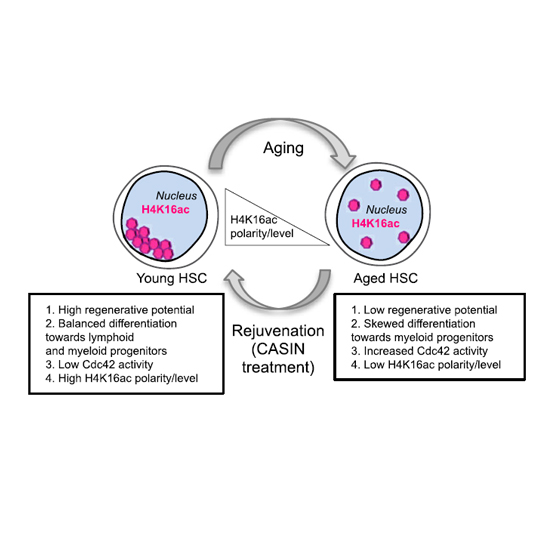LaminA/C regulates epigenetic and chromatin architecture changes upon aging of hematopoietic stem cells
07-Nov-2018
Genome Biology 2018, 19:189, https://doi.org/10.1186/s13059-018-1557-3
Genome Biology, online article
Background
The decline of hematopoietic stem cell (HSC) function upon aging contributes to aging-associated immune remodeling and leukemia pathogenesis. Aged HSCs show changes to their epigenome, such as alterations in DNA methylation and histone methylation and acetylation landscapes. We previously showed a correlation between high Cdc42 activity in aged HSCs and the loss of intranuclear epigenetic polarity, or epipolarity, as indicated by the specific distribution of H4K16ac.
Results
Here, we show that not all histone modifications display a polar localization and that a reduction in H4K16ac amount and loss of epipolarity are specific to aged HSCs. Increasing the levels of H4K16ac is not sufficient to restore polarity in aged HSCs and the restoration of HSC function. The changes in H4K16ac upon aging and rejuvenation of HSCs are correlated with a change in chromosome 11 architecture and alterations in nuclear volume and shape. Surprisingly, by taking advantage of knockout mouse models, we demonstrate that increased Cdc42 activity levels correlate with the repression of the nuclear envelope protein LaminA/C, which controls chromosome 11 distribution, H4K16ac polarity, and nuclear volume and shape in aged HSCs.
Conclusions
Collectively, our data show that chromatin architecture changes in aged stem cells are reversible by decreasing the levels of Cdc42 activity, revealing an unanticipated way to pharmacologically target LaminA/C expression and revert alterations of the epigenetic architecture in aged HSCs.











